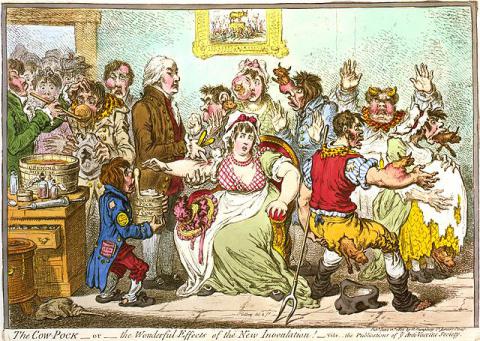Sawbones is a hilarious podcast about the ways medicine has, historically, gone wrong. On long drives with nerdy friends, I whip out my phone and we consider which episode to listen to and laugh at: Leprosy? Trepanation? Bloodletting? Plague?
The hosts, Justin and Sydnee McElroy, offer a “marital tour of misguided medicine.” Dr. Sydnee, who is an actual doctor, provides the medical and historical knowledge. Meanwhile her husband, Justin, plays dumb—for example, thinking he’s got leprosy, or positing that menstruation is a disease that needs to be cured.
But last week, Sawbones released a Very Special Episode about vaccines. It was their most requested topic, the hosts said, and they really, really didn’t want to do it. The show is supposed to be light entertainment, and they’ve avoided taking sides on any controversy—even, in the episode on homeopathy, going easy on modern-day adherents of the practice. What made them jump into the fray for vaccines? In Justin’s words: “It’s 2014, and kids are getting the measles.”
You can listen to the episode here.
The other problem with featuring vaccines on Sawbones was simply that medicine got it right. While most of the treatments they lampoon on the show are ones that sort of sound plausible, but were wrong, vaccines sound totally weird (give my kid a sick person’s pus?!) but actually work. So it’s not a history of mistakes, but for the most part a string of successes.
It is also, touchingly, at many times a story of parents trying to save their children from death. I saw in the story of Lady Mary Wortley Montagu a reflection of today’s “mommy wars” over vaccines. She was a young mom who had lost her brother to smallpox. Her husband was the English ambassador to Turkey, and while she lived there she learned about variolation, in which a healthy person is given liquid from a smallpox pustule. (If the virus involved is Variola minor, you’ll gain immunity to both that and the more serious Variola major.)
Lady Mary had her 5-year-old son inoculated in Turkey, and after returning to England, had her daughter inoculated in the midst of a smallpox epidemic. She encouraged others to try variolation, but it didn’t catch on (too foreign) until Princess Caroline allowed it for her children. And she didn’t try it until after it had been tested, first on a group of death row prisoners, and later (for good measure) on a half-dozen orphans.
OK, so they got the science right, but the ethics way, way wrong. Several times.
When Edward Jenner famously made the first vaccine—from vacca for cow—he gave it to James Phipps, the son of a poor worker. Dr. Sydnee and Justin speculate that money may have changed hands (would YOU volunteer your son to catch a cow disease?), but there’s no record of a payoff at the time (he did give Phipps a free lease on a house, later in life). Jenner then attempted to infect the child with smallpox twenty more times in his life. Fortunately for the kid, the vaccine had worked.
Worse yet, to provide colonies with the vaccine, cowpox was given to five orphans who were then shipped across the ocean.
Throughout the story, our Sawbones hosts marvel at how weird the techniques were. And yet, they worked. Weirder still, they caught on. Vaccination was such a success that smallpox was, in 1977, officially eradicated. Dr. Sydnee recalls learning the progression of smallpox lesions in medical school: “macule to papule to vesicle to pustule,” she recites, and adds that, fingers crossed, she should never have to use that knowledge.
But you know what comes next. As soon as they released that episode, mentioning in an offhand way that smallpox now only exists in two labs in the world (one in the US, one in what is now Russia), a third stash of smallpox virus was found in the back of a fridge in Bethesda.
Still, the World Health Organization keeps stockpiles of smallpox vaccine and recommends that the existing virus stocks not be destroyed, an idea that is floated from time to time. We don’t know what other refrigerators smallpox might lurk in; best to be prepared.
Beth Skwarecki is a science writer based in Pittsburgh, PA


Spread the word